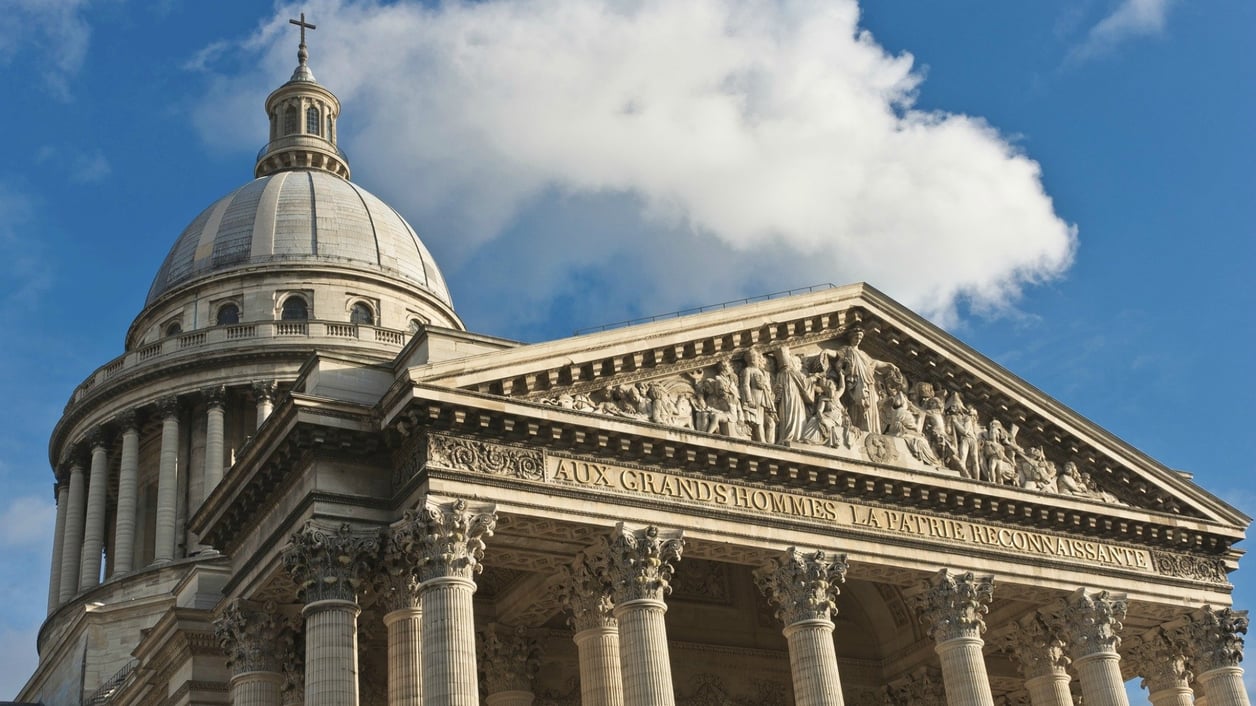Sitting atop Montagne Sainte-Geneviève in the heart of Paris’ lively Latin Quarter, the Panthéon is a mausoleum for celebrated figures in French and Parisian history, including Victor Hugo, Marie Curie and Voltaire. This beautiful example of neoclassical architecture dates back to the late 18th century and was originally built as a church. With its ornate corinthian columns and imposing dome, the Panthéon wouldn’t look out of place in Rome. In fact, architect Jacques-Germain Soufflot modeled it after the Pantheon in Rome, which was built in the 1st century. In stark contrast to the Panthéon’s heavy exterior, the interior of the mausoleum feels light and airy. Step inside and you’re greeted with beautiful tile floors, colorful paintings, intricate sculpture and an elaborately decorated ceiling. Make your way up to the external colonnade of the Panthéon’s dome and you’re rewarded with sweeping panoramic views of Paris.
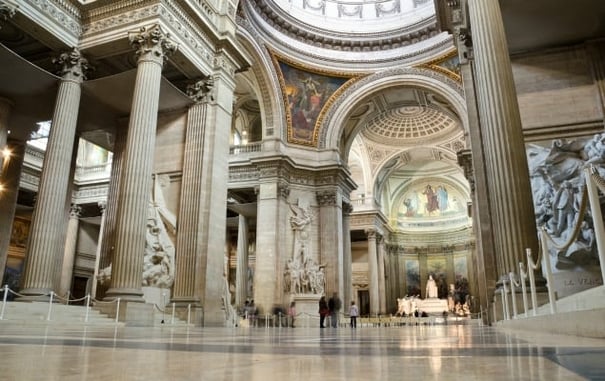
Visiting
Nestled in the heart of the 5th arrondissement, the Panthéon is just blocks away from Luxembourg Gardens and less than 15 minutes from the Cathedral of Notre Dame on foot. The sheer scale of the building stands out amongst the crooked and winding streets of the Latin Quarter. Above its grand entrance, there is an inscription that reads “Aux Grands Hommes La Patrie Reconnaissante,” or “To the great men, the grateful homeland.”
The interior of the Panthéon opens up to airy space bathed in light. A lot of the artwork and many of the sculptures in this portion of the building evoke imagery of French nationalism and the French Revolution. This can mostly be attributed to the fact that construction of the Panthéon was completed less than a year after the Storming of the Bastille and the start of the French Revolution. Also located on the ground floor is the Foucault pendulum, an exhibition designed by French physicist Léon Foucault in 1851 to illustrate the earth’s rotation.
A tight spiral staircase leads down to the Panthéon’s crypt, where notable figures from French history are interred. The crypt is a collection of hallways and arches filled with stone tombs. A few of the most recognizable historic figures found here are Victor Hugo, author of The Hunchback of Notre Dame and Les Miserables, physicist and chemist Marie Curie and enlightenment writer Voltaire.
No visit to the Panthéon would be complete without savoring the views from its dome. There are 267 steps in total, but it is not a straight climb to the top and most people find the ascent manageable. Once you reach the colonnade you are rewarded with beautiful views of the city. Though not as high as other observation platforms in Paris, the Panthéon’s location in the Latin Quarter puts you in direct line with the Eiffel Tower and the gothic spires of Notre Dame Cathedral.
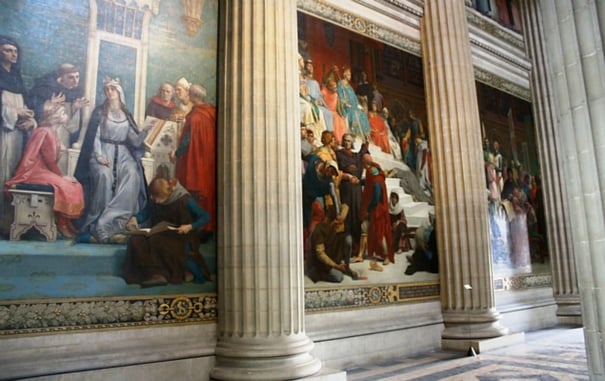
History
The Panthéon was originally built as a replacement for the Abbey of St Genevieve. An abbey stood at the summit of Montagne Sainte-Genevieve, named after the patron saint of Paris, since the 6th century. More than one thousand years later in 1744, King Louis XV found himself suffering with a major illness and vowed to replace the Abbey of St Genevieve should he ever recover. As fortune would have it, the king did recover and he commissioned a new church the following year.
Jacques-Germain Soufflot was tasked with the design of this new church. The ambitious architect used the Pantheon in Rome as his primary inspiration and the result was one of the first examples of neoclassical architecture in Paris. Construction of the Panthéon took over 50 years to complete due to economic and political problems in France at the time. By the time construction finally wrapped up in 1790, King Louis XVI had been dethroned and the French Revolution had begun. In 1791 the National Constituent Assembly ordered the newly constructed church be converted into a mausoleum dedicated to great Frenchmen. While it was twice converted back to a church and the top of the dome still retains a cross, the purpose of the Panthéon has endured as a secular mausoleum.
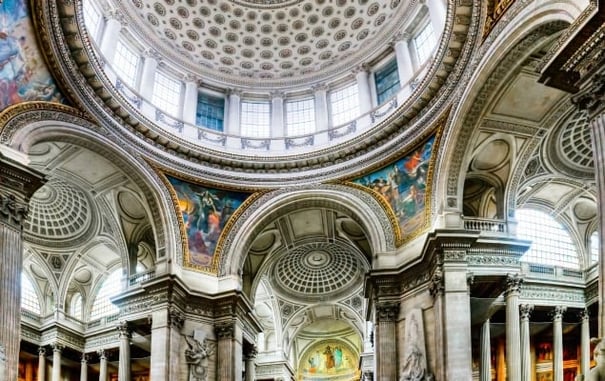
Paris Perfect's Personal Tip
The Panthéon is just one of many highlights in the Latin Quarter. Why not explore the area on a walking tour? Our walking tour of the Latin Quarter starts at the Panthéon and takes you past Notre Dame Cathedral, St. Chapelle, Place St. Michel, the Luxembourg Gardens and les Bouquinistes just to name a few!
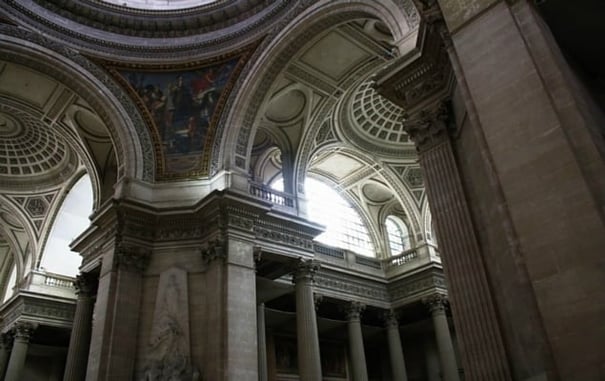
Essential Information
- Address: Place du Panthéon, 75005 Paris, France
- Closest Metro: Cardinal Lemoine, Place Monge,
- Website: http://pantheon.monuments-nationaux.fr
- Opening Times:
- Open Daily
- April 1 to September 30: 10.00am - 6:30pm
- October 1 to March 31: 10.00am - 6.00pm
- Closed on January 1, May 1 and December 25
Sign up for our Vacation Perfect newsletter and real estate updates.
